What is search intent in SEO? Using different types of keyword intent
Search intent, also known as “user intent,” is the “why” behind every search query. It’s the customer’s purpose for typing those specific words into a search engine.
Understanding search intent is crucial for creating content that resonates with your audience.
Why do people use search engines? To find information, solve problems or make decisions.
This intent often falls into one of four main categories:
- Informational.
- Navigational.
- Transactional.
- Commercial.
Let’s examine these four types of search intent closely to understand how they guide user behavior and influence the kind of content you should create.
4 types of search intent
Informational intent
Informational intent is when someone is looking to learn a fact about something, such as a definition or explanation of a concept. This is your audience raising their hands, saying, “Hey, I want to learn something!”
This type of intent usually indicates that the user is looking for detailed, accurate and reliable information to educate themselves rather than making a purchase or taking immediate action. These searches typically start with questions like “who,” “what,” “when” or “how” or include words like “guide” or “tips.”
For example, someone who searches for “what is a dslr camera” on Google might see this:

Often, these searchers aren’t even part of any marketing funnel, meaning they’re not on any sort of buying journey. If they are, they’re at the top of the funnel, exploring options and gathering information. They haven’t committed to a specific brand or product.

In the case of “what is a DSLR camera,” the person searching may ultimately end up buying a DSLR camera – but right now, they are trying to get clear on what a DSLR camera is in the first place.
They might be considering a photography career or maybe they heard about a type of camera called “DSLR” and they just wanted to get a sense of what that is.
Navigational intent
Navigational intent refers to a user’s goal of locating a specific website or page, often by entering its name or a related keyword into a search engine. This type of intent indicates that the user already knows what they are looking for and is simply using search as a tool to reach it quickly.
These searches tend to be very focused, with a specific destination in mind that the searcher easily recognizes. They use product names or brand names. They’re not messing around with modifiers or vague terms. They’re ready to go.
Because navigational searches are so targeted, official brand websites and social profiles may rank well for these keywords, often occupying most of the SERP. And, logically, they usually get the most clicks.

Transactional intent
Transactional intent describes a user’s goal to complete an action, such as making a purchase, signing up for a service or downloading a resource.
This type of intent indicates that the user is ready to engage in a specific transaction and often searches for actionable terms like “buy,” “subscribe” or “get.”
They’re not just browsing. They’re searching for the best deal, the closest location or the perfect product. These searches contain transactional terms like “buy,” “for sale,” “discount” or even “near me.”
They might be looking for “discount flights to Bali” or seeking a “pickup truck for sale.”
When this group is interested in buying something, they’re further down the funnel, closer to making a purchase and interested in pricing and purchase options.

Not all transactional intent is purchase-related. Actions like “submit,” “download” and “sign up” are often tied to transactional intent.
Commercial intent
When curiosity about brands, products or services meets buying potential, that’s commercial intent.
Many of these users are looking for information to help make an informed purchase decision. They aren’t ready to buy yet, but they’re definitely window shopping.
Think of it as the “tell me more” phase. Searches with commercial intent involve:
- Comparing options.
- Reading reviews.
- Seeking recommendations to help make a smart choice.
A commercial intent search might be “Canon Powershot Elph 360 review.” A transactional search would be “buy Canon EOS Rebel T7i.” An informational search would be “how to use a DSLR camera.”
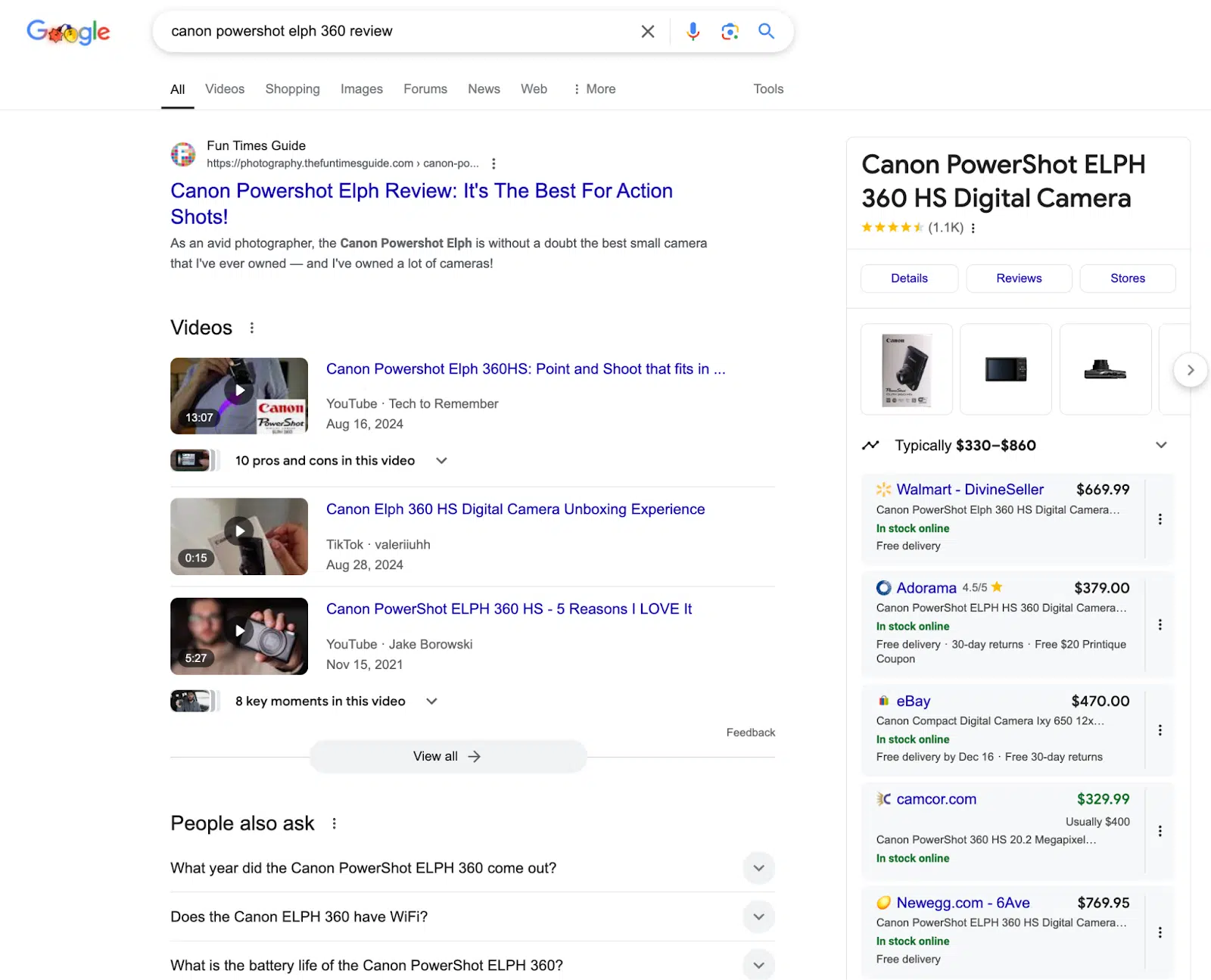
Why does search intent matter?
Understanding search intent for search engine optimization (SEO) helps you create content that gets noticed.
Why is this important?
Because only 0.44% of Google search users visit second-page results. You need to rank on Page 1 for as many relevant keywords as you can. This can boost your website traffic and increase conversions.
Google’s mission is simple: provide searchers with the most helpful, relevant results. That’s why they’re the most popular search engine.
Google even has a “Needs Met” rating scale in its Search Quality Raters Guidelines. It ranges from a “Fails to Meet” to a glowing “Fully Meets.” This describes how well a webpage meets the searcher’s expectations.
For the algorithm to work, it goes beyond keyword matching. It understands the intent behind those searches. This is keyword search intent.
Understanding search intent matters in SEO because it:
- Enhances UX (user experience): If your content matches the search intent, it gives users exactly what they’re looking for. If they have a great experience, they’ll explore your site more and take action.
- Improves CTRs (click-through rates): Search engines favor results that match user intent. When you optimize your content for intent, it’s more likely to appear in relevant search results. This often leads to a higher CTR for your site.
- Increases conversions: Say someone searching for “men’s running shoes” finds your online store. You’ve got a big selection and an easy checkout process. Cha-ching! Aligning with search intent helps convert users.
- Reduces bounce rate: A bounce rate is how many visitors land on your site, stay for a while and then leave (or “bounce”) without doing anything. But if someone searching for “symptoms of flu” lands on your article and stays to read more? Success!
How to determine search intent
Determining search intent is like having a direct line to what your audience wants and how they’re thinking. With it, you can create content that’s attention-grabbing, ranks well and converts visitors into customers.
Do you know what’s the most common search intent? Just over half of all searches are informational, followed by about a third being navigational.
But there’s a catch. Queries often have “mixed” intents. This means that they can’t squarely be put away into one of the four buckets we talked about earlier.
Take the Google search intent behind “canon cameras” for example

The searcher’s query points to a product made by Canon. Because of the brand specificity of their search, this user has some familiarity with the topic.
They might be seeking to take some sort of action related to a Canon camera – whether it’s to make a purchase, download a resource associated with one of their products or something similar. This would make their search transactional.
This user’s search would likely be fulfilled by navigating to a specific section of the Canon website focused on cameras, which is why it’s also considered navigational.
Local intent
Yes, there is another type of intent to consider. Often, local intent is a blend of informational and transactional.
A user might want to know the business’s hours or reviews (informational) before they decide to visit or buy (transactional). 0
Therefore, to effectively answer this query, you would likely need to:
- Provide detailed, helpful information about hiking boots.
- Showcase relevant products.
- Create the most comprehensive listing on Google Business Profile (GBP).
In 2024, Local Search Forum’s Joy Hawkins predicts that the top three factors influencing local business success will be:
- The quality of your website.
- The reviews on your Google Business Profile.
- How customers interact with your business.
It’s about giving people exactly what they want – right when they want it.
Luckily, there are four simple ways to find your audience’s search intent.
- Analyze keyword modifiers to determine initial intent.
- Examine SERP features for Google’s interpretation of keywords and its preferred content types.
- Understand the context of a search term to refine your keyword research.
- Use SEO tools to streamline your research and discover new insights.
Analyze keyword modifiers
Keyword modifiers are the extra words and phrases that add context to your main keyword and make it more precise and focused.
Let’s say our core keyword is “shoes.”

When “running” is added as a modifier, the keyword “running shoes” becomes more specific. This indicates a transactional or commercial intent.

Why analyze keyword modifiers?
To understand what’s brought your audience to a search engine like Google. Then, create content that targets the right customers. This would likely rank high in search results and convert more visitors into buyers.
What are some common modifiers for search intent types?
- Informational keywords often come with curious companions like “who,” “what,” “when,” “where,” “why” and “how.”
- Navigational keywords are hyper-focused on specific destinations. Think brand names like “Nike,” product names like “iPhone 15” or services like “Netflix.”
- Transactional keywords signal that someone’s ready to take action. Words like “buy,” “subscribe,” “price,” “cheap,” “discount,” “sale,” “near me” and “order” are strong indicators.
- Commercial keywords suggest that a shopper is researching options before buying. “Review,” “vs,” “best,” “top,” “alternative” and “comparison” are common modifiers here.
These modifiers can give you clues, but you’ve got to dig deeper to find the real intent, especially for transactional and commercial searches, where the lines are a little blurred.
The next step? Examine Google’s search engine results page (SERP) features.
Examine SERP features
Plug your target keyword into Google and examine the results. The search results will reveal what Google thinks is the most relevant content for that keyword.
A SERP analysis helps you:
- Nail the right content format: What’s working best for a query? Blog posts, videos or something else?
- Fill in the gaps: Discover what your competitors are missing so you can offer more value
- Gauge the competition: Estimate how difficult it will be to rank for those keywords. And plan to create content accordingly.
There are over 30 SERP features, but pay close attention to these key ones:
Featured snippets
This is position zero, appearing above all other organic results. It’s a summary of the search query, typically pulled straight from a website.
Basically, Google cherry-picks the most helpful and informative snippets to display for users. Most of these snippets are in paragraph form (81.95%), while the rest are in list form (10.77%).
- Tip: 50% of Americans use voice search daily, according to UpCity. Google’s featured snippet often answers voice searches on the SERP. Because voice search is more conversational, people often ask questions.
Say you want to get better at Instagram copywriting. You Google “instagram copywriting hacks.”
Here’s the featured snippet for the query:

The type of information here can vary between a couple of concise sentences, a short definition, a series of numbered steps or even a list. Look for clues in the keywords.
For example, “hacks” pictured here implies that the searcher is looking for a list of tips and so Google is showcasing a site with a list of tips.
‘People also ask’ section
If you scroll further down, you’ll see the questions people ask related to your core keyword. In this case, it’s for “instagram copywriting hacks”:

This section shows a list of popular questions people search for that are related to your query.
Consider these to be a blueprint to create more relevant, engaging content based on these questions.
AI Overviews
Google debuted AI Overviews in May 2024. Think of them as beefed-up featured snippets. These SERPs use generative AI to whip up quick, informative summaries from authoritative pages.
For example, a simple Google search for “generative ai” returns this result:

Notice how the summary is pulled from trusted websites like Google Cloud, IBM and TechTarget.
How do you get your content into this instant-answer spotlight? You’ll need to optimize your content so it’s well-structured, offers unique value and is easy to read – all easier said than done.
Depending on the keyword competition and how well-established your competition is, it can be more challenging to reach the AI Overview.
In general, the easier it is for Google (and users) to understand the information on your page and recognize your expertise, the more likely your content is to appear in AI Overviews.
Understand the context of a query
A search’s context can help you figure out a user’s intent, like following a trail of breadcrumbs.
A location-tagged search? They probably want to find something nearby.
Searching from a mobile device? They probably need access to on-the-go information.
About 40% of people search only on their smartphones on an average day to get what they need. It’s easier to rank well in Google if your site is mobile-friendly. So responsive design and fast loading times are key.
If you localize your mobile experience, expect a 67% boost in conversions from smartphone users. But how do you measure your audiences’ digital habits?
Try Semrush’s Keyword Overview tool to get a sense of difficulty to rank, audience breakdown by device and geography and other related metrics.
Let’s plug in the keyword “best electric toothbrush for sensitive teeth” into the tool:
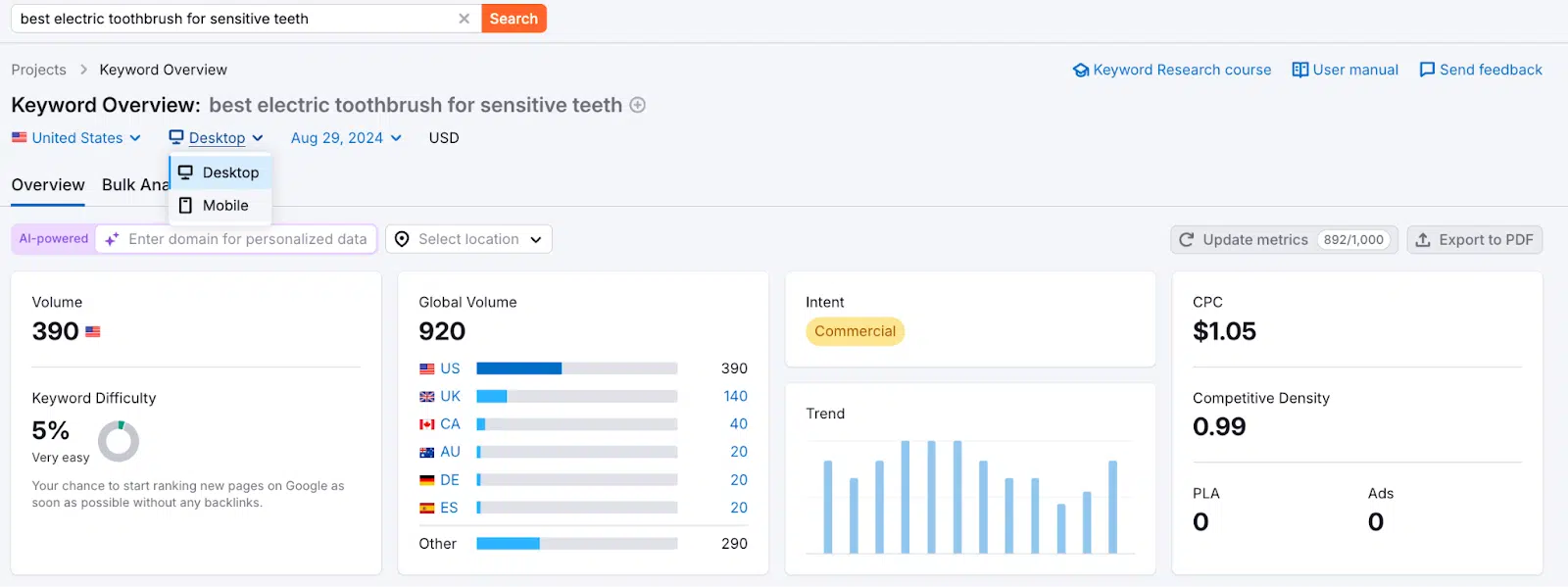
Use a dedicated search intent tool
A winning SEO strategy starts with understanding user intent. But let’s face it, manually checking results for every keyword is a grind.
Semrush’s Keyword Overview tool automates the process, allowing you to determine user intent faster.
Sticking with the keyword “best electric toothbrush for sensitive teeth, let’s use the tool to identify user intent.
- Tip: Enter your website’s domain name to get AI-powered personalized suggestions.

With an entire section dedicated to intent, you can clearly this keyword is tied to commercial intent.
But this dashboard adds more color by summarizing monthly search volume, displaying any seasonal trends and even offering PPC data for you to cross-reference.

Reference table: What’s behind a search query?
This handy reference table identifying the main types of search intent, their purpose, SERP features and example queries will help guide you as we move on to discussing how to optimize content for user search intent:
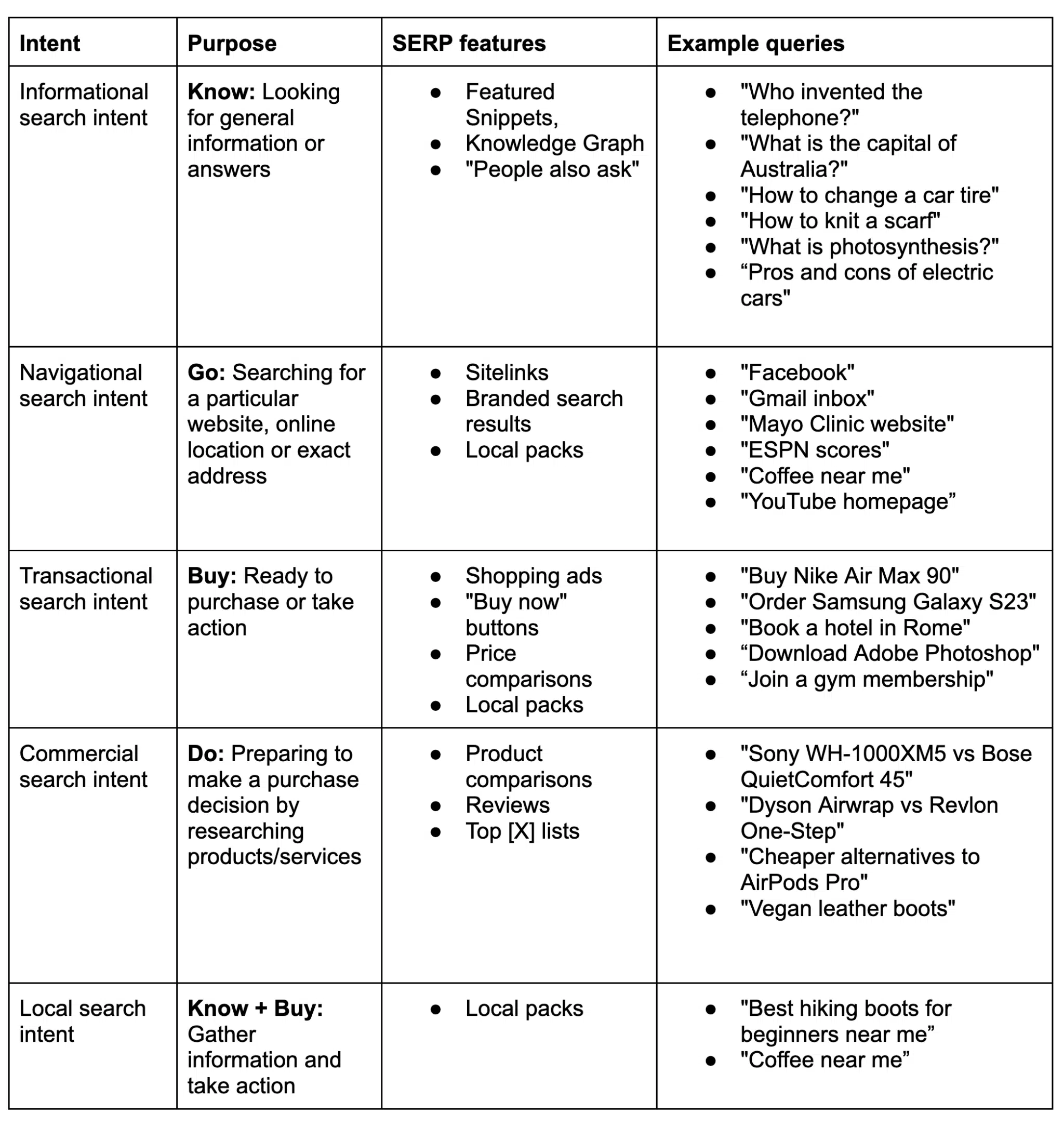
How to optimize content for search intent
A successful search intent optimization strategy is part of your overall SEO strategy. Here’s a list of the three best practices to optimize for search intent.
Align your content with the ‘3Cs of search intent’
To align your content with your keyword, determine the 3Cs of search intent:
1. Content type
What type of content is most common in the search results?
Are the top results mainly blog posts, product pages or something else? You can use this to figure out what Google favors for that query.
For example, consider the keywords “best beers in the U.S.” Semrush’s SERP analysis shows that articles and blog posts are the dominant content types here.

Breweries’ own boastful product pages likely don’t interest users at this stage. They’re looking for someone who’s sampled a range of American beers. They want unbiased opinions and expert recommendations.
2. Content format
Next up: How are the top-ranking pages formatted?
Do the top results have how-to guides, in-depth reviews, comparisons or listicle-style roundups?
Analyze what format resonates most with searchers. Then, adjust your search intent optimization efforts accordingly.
Content format can apply to many types of content. But it’s especially relevant to blog posts.
Here are some popular formats to consider:
- How-to guides that provide detailed instructions and step-by-step instructions.
- Step-by-step tutorials with detailed, visual guidance, often including images and videos.
- List posts featuring resources, tips and examples on a particular topic.
- Opinion pieces backed by evidence and reasoning that express a viewpoint or perspective.
- Reviews of products, services or experiences that offer pros, cons and recommendations.
- Comparisons of two or more options highlight their similarities and differences to help make decisions.
For our keywords “best beers in the U.S.,” the search results lean heavily toward list posts.

3. Content angle
Finally, what’s the main selling point of the top pages?
Do they emphasize price, convenience, expert insight or something else? This shows what users value most when searching for that keyword.
Looking at the SERP analysis for the query “best beers in the U.S.,” the dominant content angle seems to be centered around curation and authority.
The top two results explicitly mention “best” and “top-rated” American beers, showing users are looking for trusted recommendations:

Update title tags and meta descriptions to match search intent
Suppose someone searches for “noise canceling headphones for studying.”
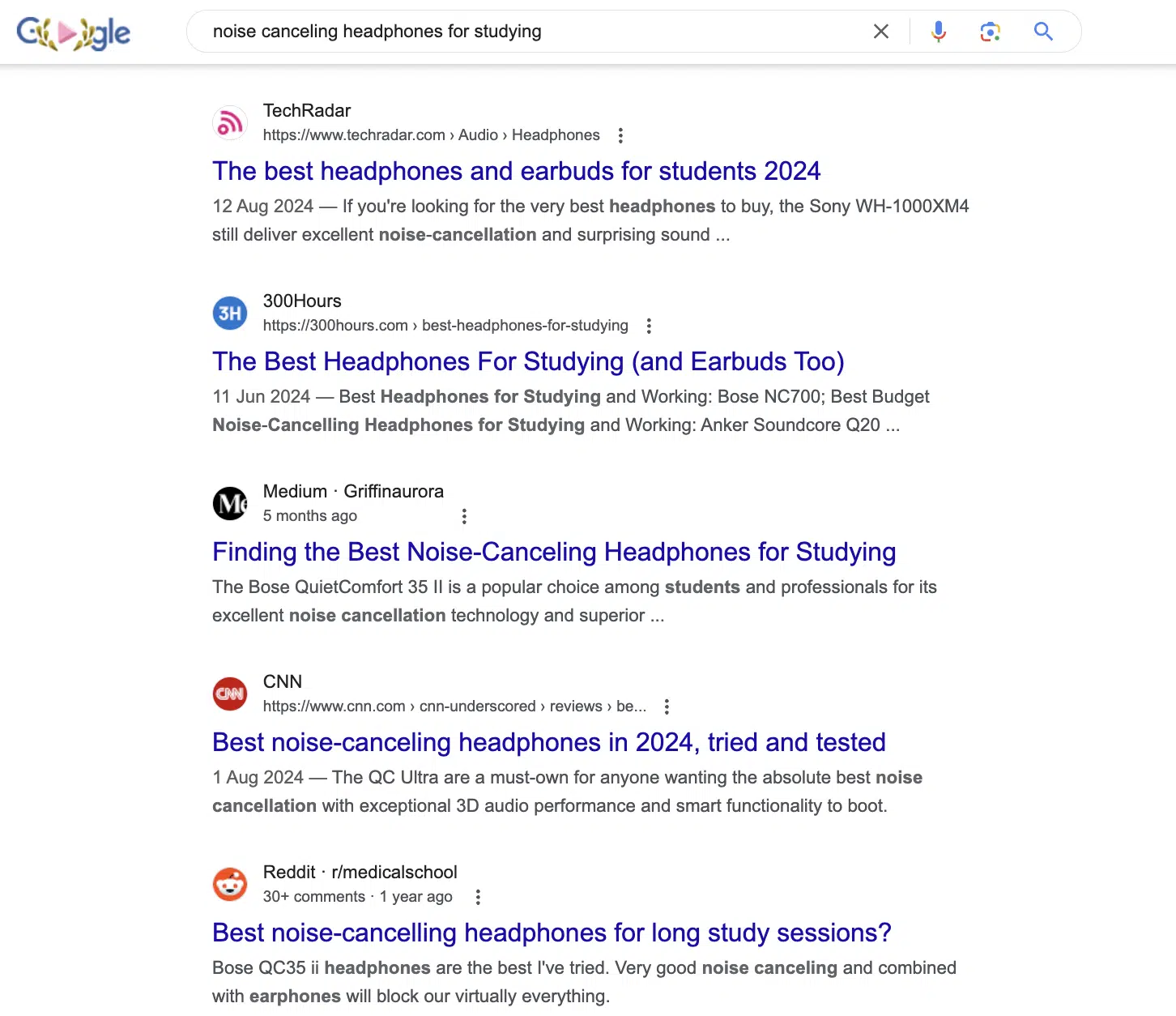
There’s more to the top results than just that exact phrase. They’ve also included terms like “popular choice,” “best” and “must-own.”
These subtle cues signal to the searcher, “Hey, we get it – you’re doing your research before buying. We’ve got all the info you need!” CTRs increase when people know what they’re clicking on.
How?
- Match your language to the searcher’s intent. For someone searching for “buy new laptop,” use action-oriented words like “shop” or “order” to show them you’re ready for business.
- For a query like “learn about climate change,” terms like “guide” and “understand” signal educational content. They want knowledge and you’re going to serve it.
Find question-based keywords related to your industry or niche. Make sure your content answers those questions comprehensively. Create FAQ pages, blog posts or even video tutorials to address this informational intent.
Semrush’s Keyword Overview tool can give you some jumping-off points by detailing specific questions, their relative popularity (based on search volume) and popular variations.
For example, question variations like “are noise canceling headphones worth it for studying” suggest a content opportunity beyond just a list of top headphones.
A buyers’ guide or cost breakdown for noise canceling headphones could help you attract more of your target audience.

Optimize for visual intent
Consider search intent not only in terms of words but also in terms of images.
Image Packs are a common SERP feature. But true visual intent success? This means ranking in the top 10 results, getting multiple image rows or doing well on image-focused platforms like Pinterest.
Here are some best practices for optimizing for visual search intent:
- When adding images, think of relevance first: Don’t just grab something pretty. Choose something that adds meaning to your text. Use, for example, a close-up of an electric toothbrush. Highlight its gentle features that are perfect for sensitive teeth. Avoid a generic image of a person brushing their teeth.
- Use high-quality visuals that support your message: And don’t distract from it. About 30% of U.S. shoppers won’t buy if the images are missing or of poor quality (such as blurry or out of frame).
- Don’t forget the technical side: Use responsive images, supported formats, image optimizations to help images load clearly and quickly and descriptive alt text. In a 2021 discussion about alt text, Google Developer Martin Splitt confirmed, “Alt text is important for SEO too!”
- Think about how you can weave short videos into your articles: For an extra boost of engagement, how about video tutorials or webinars? These can be embedded onto your site or shared through social media. You can drive further user action while also boosting time on page.
Address mixed intent
Unfortunately, search queries aren’t always black or white. There’s a type of search that doesn’t neatly fit into a single category: the mixed intent query.
This query is a bit of a curveball because It requires you to address multiple needs at once. Mixed intent is frequently found in keywords blending informational and commercial intent, such as “how to shop for a new car.”
How do you create content when the query intent is mixed?
Embrace the hybrid. Don’t pigeonhole your content into one category. If the query has informational and commercial intent, provide both educational value and product recommendations.
Let’s revisit the search term “best DSLR cameras for beginners” for our example. This term could reflect transactional intent while someone is shopping for a new camera. It could also be informational if searches are looking for ways to evaluate a DSLR.
- Structure for success: Guide the reader with proper formatting. Organize your content with clear headings and subheadings. Perhaps start with a section on “Understanding DSLR Camera Basics.” Follow that with “Top-Rated DSLR Cameras for Beginners” and a comparison table.
- Use visual cues: Include images. Show different camera models, their features and people using them in different settings. You could also include an infographic comparing the key features of several cameras.
- Add clear calls to action (CTAs): Include links to product pages or reviews within your recommendations. Use phrases like “Check Price” or “Read Reviews” to encourage users to take the next step.
- Remember that user experience is king: Make your content easily navigable and scannable. Use bullet points and numbered lists. Create a table of contents at the beginning so customers can jump to the sections they’re most interested in (e.g., learning about camera features, seeing recommendations).
The more you cater to both the informational and commercial aspects of the query, the higher the chance that your audience will stick around. (And hopefully, shop around, too.)
How to measure and build process around your search intent optimization success
You’ve done the work for intent-driven searches. But how do you measure the fruits of your labor?
Here are three convenient methods:
Examine Google Analytics from a search intent perspective
Analyze Google Analytics through the lens of search intent.
Why?
To see how well your content aligns with your audience’s needs.
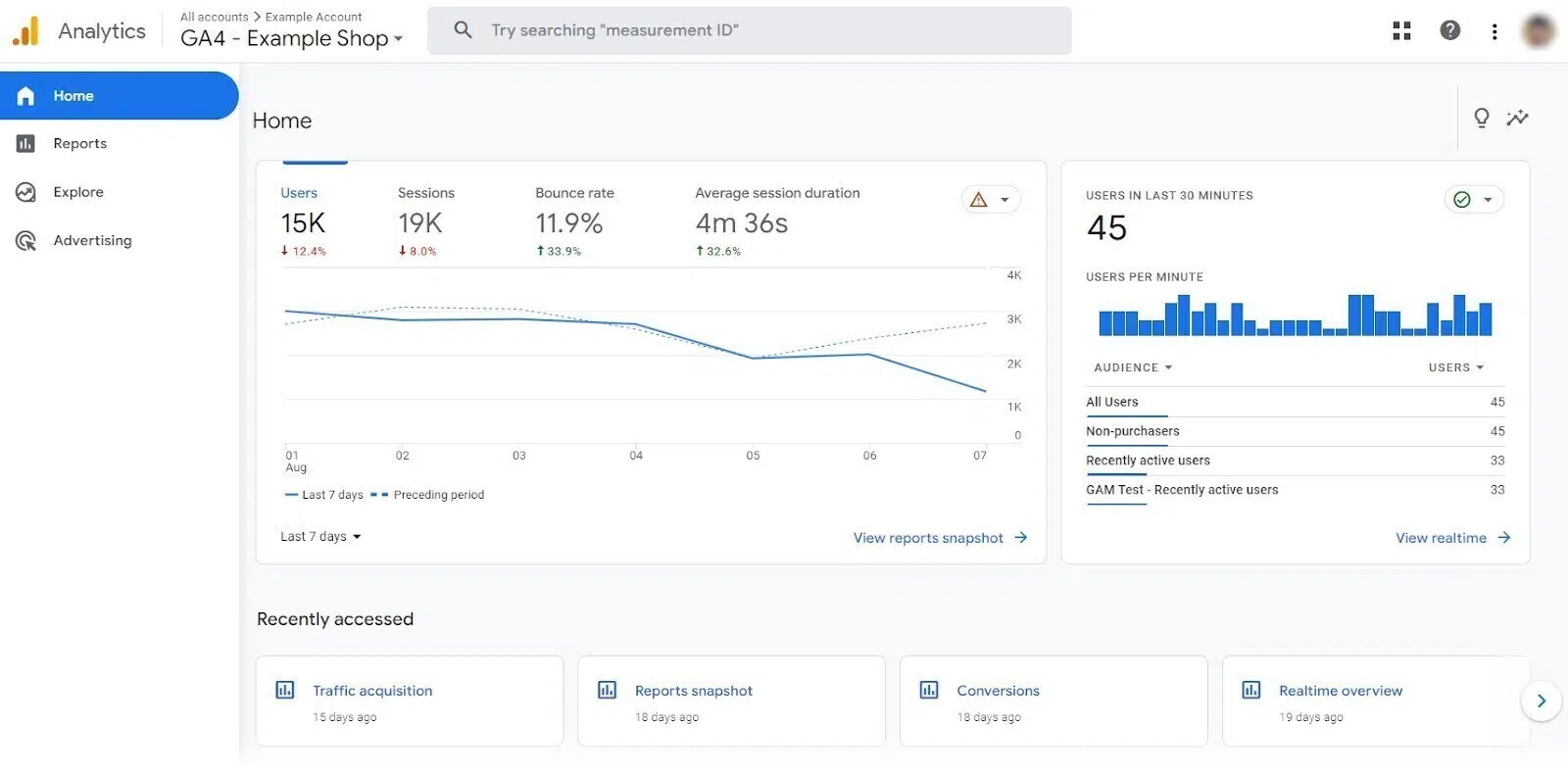
Here’s what you can track:
- Landing pages and bounce rate: Find landing pages with high bounce rates. The search query that brought users to the site might be disconnected from the actual content on the page. Analyze the keywords leading to high bounce rates. Are they targeting the wrong intent? For example, someone searching for “best laptops under $500” lands on a page comparing high-end gaming laptops. They get frustrated and bounce.
- Top converting pages and keywords: Find out which pages convert best (sales, sign-ups, downloads, etc.). These keywords are likely to be high-converting since they match user intent well. Find common themes or patterns among these high-converting keywords. You can use this information to guide your future content creation and keyword targeting.
- Content engagement metrics: Monitor metrics like average time on page and pages per session. Does your content have a high engagement rate on specific pages? This is a good indicator that your content is resonating with the user’s intent.
Use SEO tools to track progress
Use a tool like Semrush’s On Page SEO Checker to measure your search intent optimization success. Review the data it provides to see if your content aligns with user intent and search engine expectations.
A good SEO tool should allow you to:
- Track keyword rankings over time: A rise in rankings, especially for intent-based keywords, shows that users and search engines like your content.
- Analyze on-page optimization scores: Semrush’s On Page SEO Checker gives you a score and specific recommendations for improving your pages. You can see what’s working, what needs improvement and where you can double down.
- Monitor SERP features: Track your progress in SERP features, like featured snippets and “People also ask” boxes. Visibility here shows high-quality, informative content that meets user intent.

For example, here’s Semrush’s On Page SEO Checker’s recommendations for a website’s pages:
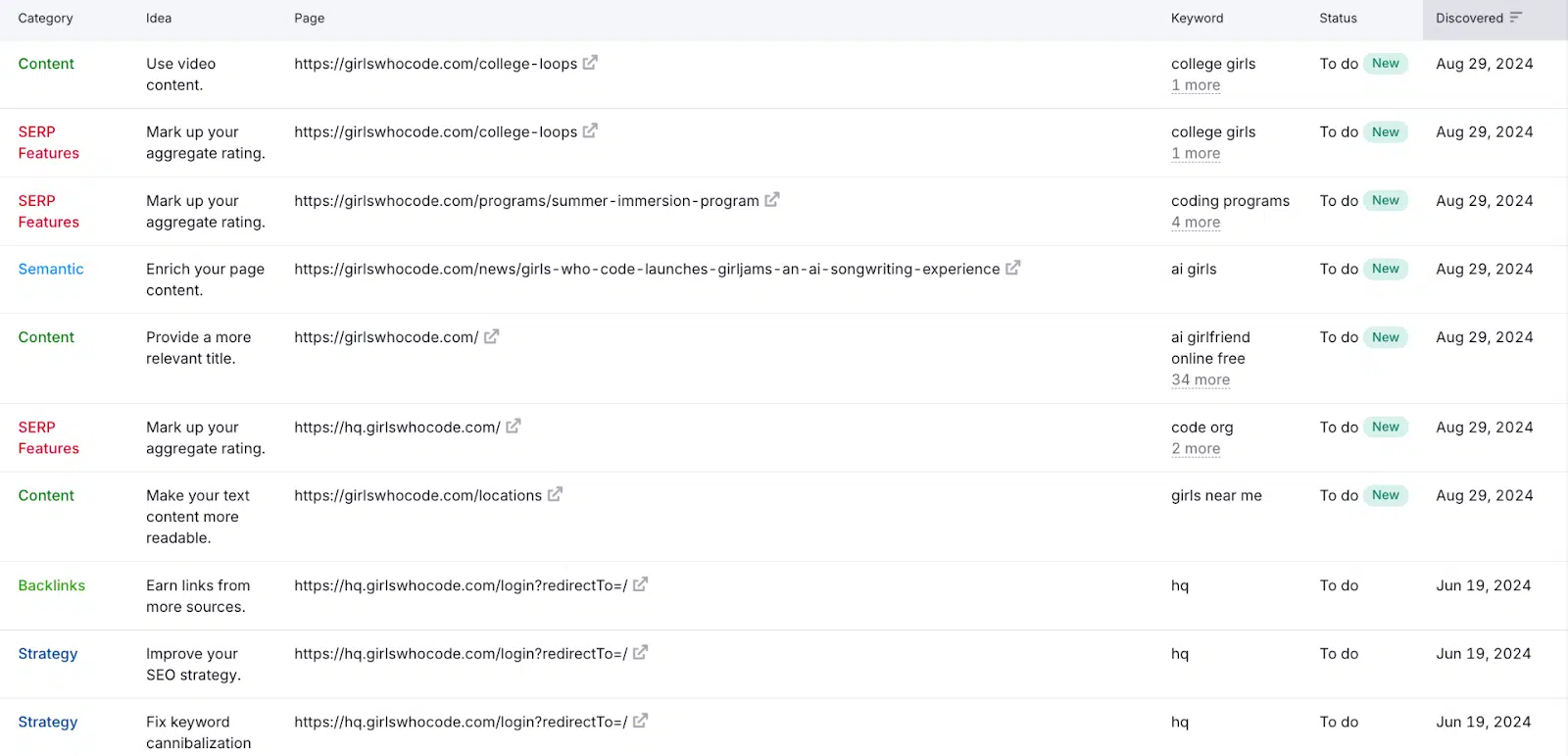
Website URLs are listed by category of optimization, such as “SERP Features” or “Content,” but offers more detail beyond that.
Some of these recommendations have more to do with search intent than others.
Export this data and you can add your own columns – such as “search intent” – to reflect how some of these recommendations require immediate clarification of search intent.
For example, for the content-related optimization around “Provide a more relevant title” to be effective and “relevant,” you must know your audience’s needs.
Deploy A/B testing
Think of SEO A/B testing as a science experiment for your website.
You hypothesize something about visitor behavior when navigating your site, then modify a single variable at a time compared to your baseline, “standard” visitor behavior and see what impact that variable has.
This gives you real-world data that can readily extrapolate into real-world success. Keep changes that show an increase in organic engagement to help boost search rankings.
Here’s a breakdown of the key steps to implement A/B testing on your pages:
- Choose your testing ground: Choose pages on your site with a lot of historical data. (Think product pages, blog posts within a category, etc.)
- Form a hypothesis: Estimate the impact of your changes based on your SEO knowledge and target search engine. For example, you might want to optimize meta descriptions for target keywords and improve page load speed. Say you expect to see a 5% increase in organic traffic within three months.
- Divide and conquer: Separate your pages into two: a control group (unchanged) and a variant group (with your changes). A fair comparison requires both groups to have similar traffic patterns.
- Make your move: Make the changes to the variant pages and let the experiment run.
- Analyze and decide: Compare actual traffic to forecasts for both groups. If the variant group improves significantly over both its forecast and the control group, you’ve got a winner! Otherwise, it’s back to square one.
The combined knowledge from Google Analytics, Semrush and A/B testing experiments allows you to refine your strategies and optimize your web pages.
The result? Deliver an exceptional user experience that boosts organic traffic, boosts conversions and ultimately fuels your business growth.
Rock the SERPs with search intent
The more you know about what your audience really wants when they search on Google (or any other search engine), the better you can meet their needs – and drive traffic to your site.
Nail that and your content will rank high, get clicks and keep people interested.
Keep reading to dive deeper into search intent vs. relevance or to drill down further into A/B testing. We recommend you dig into the latest on how people are using Google.